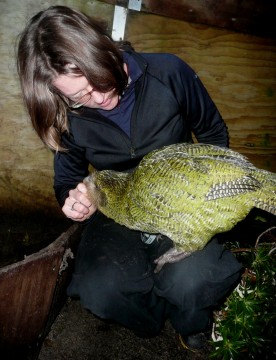Kai-to-go for Kakapo: Part 1
Guest Blogger: Kakapo feeder, Stephanie Gray
By the look of the empty feed bowl, Sinbad enjoyed his kumara cubes and macadamia nuts last night.

Kakapo feeder Stephanie Gray gets to know one of the juvenile kakapo on Codfish island
He’s tidy too, leaving only a few crumbs, unlike the chicks who scatter lumps of pasty, half-chewed pellets up to two meters from their hopper—a kakapo feed station. I start to wipe down the hopper when, with a rustle of leaves and little grunt, Sinbad pokes his head through fern fronds.
The feed-out map and guide I carry mentioned that this particular bird may be roused from daytime slumber to visit, but I’m still taken aback at the sight of this beautiful, inquisitive creature. Sinbad ambles past again, lifting huge clawed feet high above the muck of peat mud and I blurt “Sinbad, you’re amazing. I love you.”
Sentimental, yes, but I’m far from the first human to fall for the mossy green and gold kakapo. Naturalist and author Gerald Durrell once expressed the hope that if he went to heaven he hoped to find “a troop of kakapo to amuse me in the evening instead of television.”
I’ve the good fortune to be stuck in the mud with the world’s largest and most endangered parrot as a Wellington Zoo volunteer on Codfish Island (Whenua Hou). Volunteers support the year-round work of the National Kakapo Team and I’m here to help with the supplementary feeding that the team hope will trigger increased breeding.
I was up with the sun this morning to help Errol feed the last three chicks in the holding pen near the hut. The fully-feathered youngsters are keen for a feed before settling down to sleep the day away, and as Errol crop-feeds one chick, another clambers onto my knee to gently chew my fingers.
That morning I set off for the summit side of the valley to loop around seven hoppers. At each, I disinfect all surfaces, swap an empty hopper for one filled with a weighed portion of pellets moistened with flaxseed oil, and painstakingly scrape every mushy crumb of food from the ground. Cleanliness is crucial—kakapo are vulnerable to respiratory illness that may be caused by mould, and no risks are taken.
Half-way through my loop I meet up with Steve and Dana, who with VHF antennae, scales and admirable fitness, are on this side of the island to catch and weigh four recently-released juveniles.
I tag along for an afternoon of what Steve later describes as “epic bush-crashing”. Off the track to find the birds in the logs and hollows they nestle in during the day, we weave our way through webs of supple-jack—the masses of thick vine lassoing packs and limbs.
In the bush, with kaka and kakariki raucous overhead, we hear a helicopter announcing the arrival of three new birds from another island, among a load of medical supplies, groceries and a new computer.
The groceries supplement an impressively stocked larder; it’s my turn to cook tonight and I’ve spied the cashew nuts that will top off a tofu and udon noodle stir-fry. So I better get cooking! Part II to follow in the next few days…
